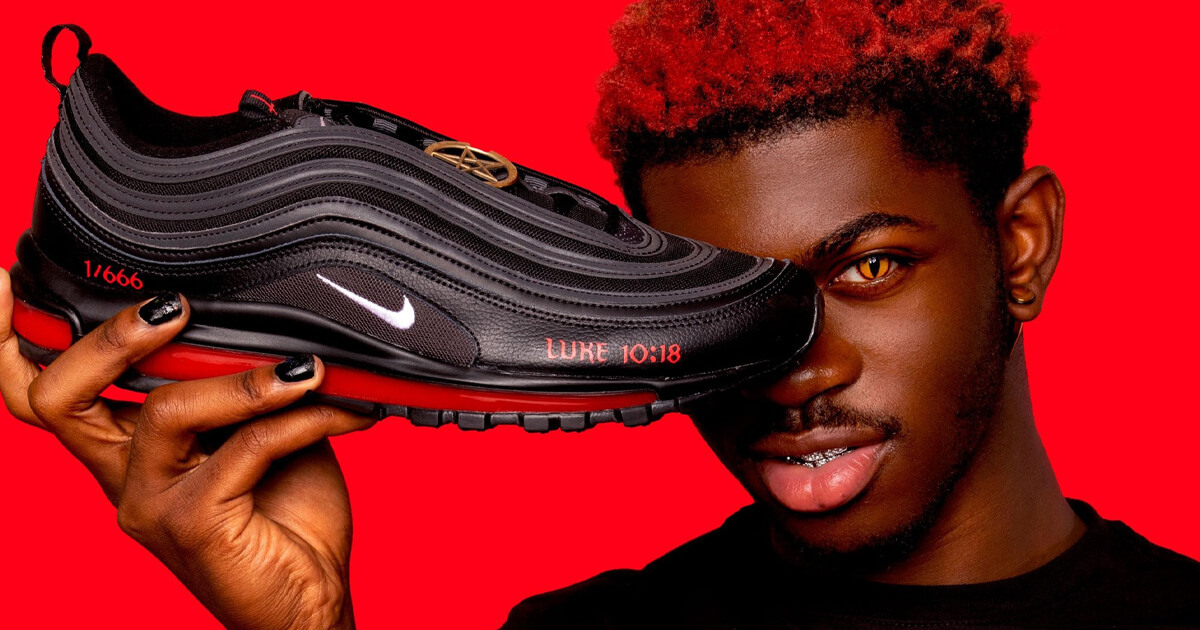The Devil is in the Details

 By Arianna Marks
By Arianna Marks
Associate General Counsel
Beanstalk
Recently, Lil Nas X of “Old Town Road” fame released a new song and music video combining themes of satanic messaging and sexuality. As part of Lil Nas X’s campaign surrounding the song release, the artist partnered with a design studio called MSCHF Product Studio, Inc. (MSCHF). MSCHF and Lil Nas X collaborated to create 666 pairs of customized Nike Air Max 97 sneakers that contain drops of human blood in the sole of the shoe and feature a pentagram pendant. This comes after Lil Nas X released his new music video where he dances with the devil (incarnate) in a seductive manner.
Shortly after the song and video release, the “Satan Shoes” were put on sale, began trending on social media, and sold out by the end of the day. Presumably, part of the goal of this campaign was to spark conversation and gain attention, which was quickly accomplished. Little did Lil Nas X know, the intellectual property implications surrounding this narrative are complex and intriguing.
Without hesitation, Nike filed suit against MSCHF accusing them of trademark infringement, false designation of origin, trademark dilution and unfair competition in violation of the Lanham Act (the federal statute that governs trademark infringement), as well common law trademark infringement and unfair competition.
Nike’s complaint specified that the sneakers prominently feature Nike’s Swoosh logo, one of the most recognizable brand logos in the world and, according to Wikipedia, the most valuable, having a worth of $26 billion alone. Nike asked the court for declaratory and injunctive relief in order to force MSCHF to permanently stop fulfilling orders for the sneakers, as well as monetary damages.
Nike’s claim is supported by the primary function of a trademark, which is to prevent consumer confusion among competing producers of goods and services. In order to prove trademark infringement, the owner of a trademark must show that there is a “likelihood of confusion” between the plaintiff’s trademark and the allegedly infringing mark.
A touchstone of trademark law is that trademarks are specific to the goods and services that the trademark owner provides. Often times, federal courts also take the approach of utilizing a test to measure the competing interests of the parties. In this case, the interest of both parties is quite similar, selling sneakers. The test requires a trademark used in an expressive work to “[have] no artistic relevance to the underlying work” or “explicitly mislead as to the source” of the work before it is deemed to be an infringing use.
Therefore, Nike would need to take on the heightened burden of proving that there was a likelihood of confusion as well needing to satisfy the “explicitly mislead as to the source” test.
Applying these standards, Nike will presumably argue that the combination of Nike’s incredibly broad reach, Lil Nas X’s celebrity and MSCHF’s use of the Nike trademark on the “Satan Shoes” creates a strong likelihood of confusion for consumers. This confusion is likely to lead consumers to believe that the sneaker was released as part of an endorsement deal or pre-meditated collaboration. Nike can rely on the fact that they frequently engage in collaborations similar to this one to support the argument that there was in fact a likelihood of consumer confusion.
Nike also claimed severe reputational harm to the brand’s goodwill due to its consumers’ association with Nike and satanic messages. Now, members of Nike’s loyal customer base may mistakenly believe that Nike endorses satanism. Nike’s argument is bolstered by the fact that MSCHF was benefiting from Nike’s goodwill in prominently displaying the Swoosh logo to the “Satan Shoes” by diverting Nike’s customers to purchase from MSCHF. Public perception is the name of the game in the branding world and when the public interacts with these sneakers, the inclusion of the Nike Swoosh logo will likely symbolize that Nike is the source of the product. Further, the substantial backlash from social media users appears to evidence consumers’ belief that Nike was the source of this product.
In Rolex v. Agarwal, the court found that the First Sale Doctrine does not apply when refurbished products bear the marks of the original manufacturer but have later been refurbished with non-genuine parts. Here, MSCHF adapted the sneakers by including human blood in the sole and affixing a pendant that was not genuine to Nike. This supports the notion that MSCHF will likely be unable to rely on the First Sale Doctrine.
While presumably Nike is seeking a victory in the court based on legal merit, a favorable judgement is most likely not the only motivating factor in this suit.
Regardless of the success of Nike’s claim, trademark owners are encouraged to work diligently to protect their trademarks from infringement, unfair use or tarnishment that may impact their brand equity. Although this enforcement is not required, a trademark owner’s lack of enforcement will weaken the strength of the owner’s mark in commerce. By Nike filing this lawsuit, Nike is essentially putting the world on notice that any attempted infringement of the Nike trademarks will be immediately pursued to the full extent of the law. This also sends a public relations message that Nike does not endorse this product and is so at odds with the message behind the product that they will invest the time, costs and resources required for litigation to prevent this type of infringement. It will be interesting to see the court’s analysis here, as we know, the devil is in the details.




